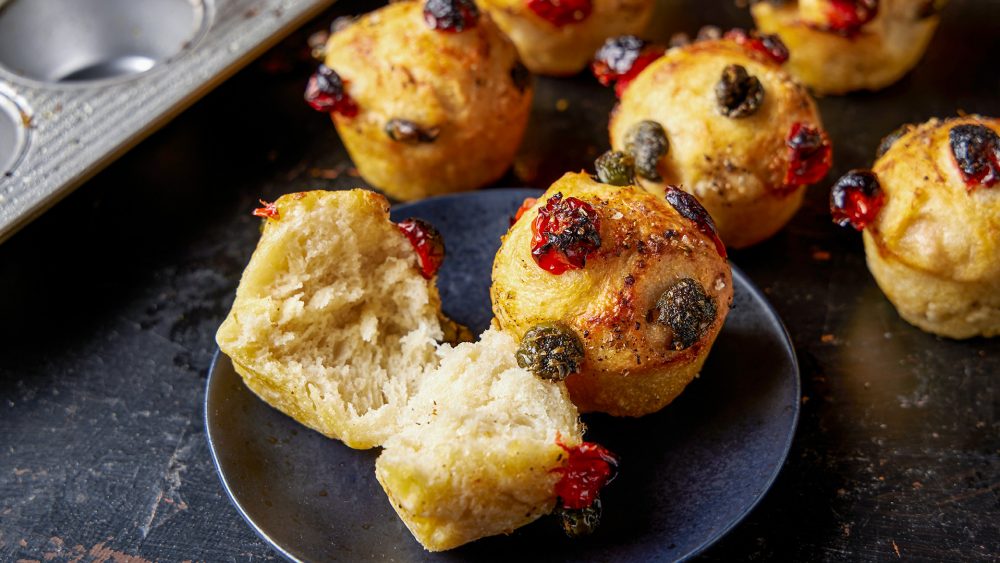Way, Way More Water is Key
With bread, it always comes back to gluten. One of the ways to control or inhibit gluten formation is to up the amount of water in dough. Fiore’s source recipe has 1 1/2 times the usual ratio of water to flour—one might as well call it a batter, it’s so wet. This leads to weaker gluten, which means an airy, open, irregular structure.
Don’t Skimp on the Oil
If your focaccia isn’t dripping with olive oil, I don’t want it. Here, you’re oiling your dough before its first rise, brushing your muffin tin with a generous amount of oil and drizzling the prepped mini focaccias with olive oil right before baking. This is not a moment to hold back. Not only does olive oil flavor the dough, it fries the focaccia along the edges and base for the crispiest finish.
Break Out the Equipment
The focaccia recipes I’ve made before are pretty low-tech, requiring little more than a spatula or wooden spoon to pull together a sticky dough. This focaccia takes a little more muscle because of its high moisture content. To assemble the dough, combine flour, yeast, sugar, water and salt in a stand mixer with the dough hook attachment.
This is actually genius. The recipe headnote warns against adding excess flour to make handling such a wet, slippery dough easier. By letting the stand mixer do the hard work then scraping it into an oiled bowl, we skirt a common pitfall. Extra flour here would tip the focaccia’s texture out of airy territory into dense and brick-like.
A Long, Slow Rise is Key
Plan your baking around a long proof. Standard focaccias rise about one to two hours. Fiore’s rises for four. Ours goes for a whopping six.
Given that most of our kitchens don’t have the blazing heat of a pizza oven to help the rising along, it takes six hours for our dough hit the hallmarks of Fiore’s recipe: The dough must double in volume, deflate, then rise again. We’re letting the yeast tucker itself out, so there won’t be quite as impressive of a lift in the final bake—the point at which yeast usually exerts its last little bit of energy, something we normally strive for—but this departure from the norm is worth it. This sequence of rises and falls creates more gas than a perfunctory rise (even though we lose a bit as dough deflates) giving us the air pockets and tender texture we’re looking for.
Handle with Care
Remember when everyone was making focaccia during lockdown? My Instagram feed was a parade of people pushing slick fingers into rested dough to make focaccia’s signature dimples or generally rough-housing their dough under the guise of focaccia being a nearly infallible bake.
Here, since we’ve worked so hard to capture air in our dough, the goal is to handle it as little as possible in the final stages before baking, lest we knock out any gas. Use a cookie scoop, disher or two spoons to carefully portion dough into the wells of your prepped muffin tin.
Get a Pizza Stone!
One thing standard muffin pans do really well is give you sides and bottoms that are evenly cooked. Well, we’re trying to approximate a 600-degree Fahrenheit pizza oven, so an even golden crumb is not the point.
A pizza stone, pre-heated at 500 degrees Fahrenheit for at least an hour before you’re ready to bake, gives us the blazing hot base we need for a dazzling, browned bottom on every mini focaccia. Baking focaccia in a muffin tin creates more browning because more of the dough makes contact with the pan, and the pizza stone ratchets up the heat. If you want to invest in a great one, I recommend this one by Fiero Forni or a classic Baking Steel.
Prep Your Toppings Wisely
Here’s a clever trick: To avoid any pools of moisture when using cherry tomatoes for savory bakes, mash them lightly before use! This helps release some of their juices before adding to the dough.
And did you know that the only difference between green and black olives is when they’re harvested? Green ones are picked and cured before they’re ripe, while black ones are harvested and cured after they’re completely mature. Buttery Castelvetrano olives, which are called for here, are becoming easier to find widely, but if you can’t, still opt for a green olive. They have a slightly milder flavor that plays well with other ingredients.
Push the tomatoes and olives deeper into the dough than you might think you need to, as the focaccia will puff up while baking, and you don’t want your delicious toppings rolling off.
Do They Keep?
Yes. Baking focaccia off as muffins rather than a loaf gives you a whole extra week of fresh, moist bread. Usually, slicing into a focaccia means it starts to go stale or dry right away, no matter how skillfully I wrap it. Because each mini focaccia is self contained, that problem is solved—all they need is a quick reheat in the oven if you want them warmed up.
Join the conversation on Facebook, Instagram, TikTok and Pinterest.
And if you're looking for more Milk Street, check out our livestream cooking classes with our favorite chefs, home cooks and friends for global recipes, cooking methods and more.








